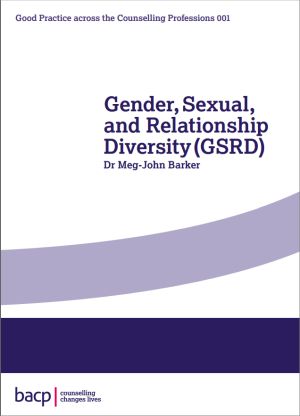We believe every individual should have access to non-judgemental therapy, whatever their sexuality, gender identity or relationship style. This should be provided by an informed practitioner, committed to delivering skilled and evidence-based therapy.
We're committed to continuing to work within the area of gender, sexual and relationship diversity, to further broaden our knowledge, understanding and learning about the issues faced by our clients and the public.
This resource has been developed in partnership with Dr Meg-John Barker, a leading expert in the field of gender, sexual and relationship diversity, to support our members and other counselling professionals in their work.
We recognise there is currently much debate on issues relating to gender identity. This resource has been produced to support BACP’s (and other professions) position in respect of conversion therapy. This is set out in the 2017 Memorandum of Understanding (MoU). This makes it clear that conversion therapy in relation to gender identity and sexual orientation (including asexuality) is unethical, potentially harmful and is not supported by evidence. It considers gender identity, interpreted broadly, to include all varieties of binary (male or female), non- binary and gender fluid identities.
For more information, see:
Contents
- Introduction: Gender, Sexual, and Relationship Diversity (GSRD)
1.1 How does British culture understand gender, sexuality and relationships?
1.2 Why this is relevant to mental health and therapy
1.3 Situating the current view in time and place
1.4 What is Gender, Sexual, and Relationship Diversity (GSRD)?
1.5 Why an intersectional understanding is vital
1.6 The legacy of non-affirmative and pathologising practice
1.7 Working affirmatively across GSRD - Sex/Gender
2.1 What is sex/gender?
2.2 A biopsychosocial understanding of sex/gender
2.3 Gender assignation: intersex and diversity of sex development (DSD)
2.4 Gender status: trans
2.5 Gender status: cisgender
2.6 Gender identity: woman
2.7 Gender identity: man
2.8 Gender identity: non-binary
2.9 Good practice across sex/gender diversity - Sexuality
3.1 What is sexuality?
3.2 Identities, practices/experiences, and attractions
3.3 Extent of attraction: the asexual spectrum
3.4 Gender of attraction: bisexuality, pansexuality and queer
3.5 Gender of attraction: lesbian and gay sexuality
3.6 Gender of attraction: heterosexuality
3.7 Sexual practice: BDSM, kink, and beyond
3.8 Consent
3.9 Good practice across sexual diversity - Relationships
4.1 Relationship diversity
4.2 Solo-ness and singledom
4.3 Monogamies
4.4 Secret non-monogamies
4.5 Open non-monogamies
4.6 Aromantic experience
4.7 Relationship anarchy
4.8 Sex work
4.9 Good practice across relationship diversity - Summary of good practice for culturally competent work across GSRD
Further Resources

Using good practice across the counselling professions resources
These resources are not contractually binding on members but provide general information on particular fields of work, in the context of BACP’s core ethical principles, values and personal moral qualities.
Individual practice issues are often complex and will vary depending on your clients, models of working, the context of the work and the kind of therapeutic intervention provided. We'd always recommend discussing practice dilemmas with a supervisor, a legal advisor or another suitably qualified and experienced professional.
